The AMD Radeon R9 Nano Review: The Power of Size
by Ryan Smith on September 10, 2015 8:00 AM ESTCompute
Shifting gears, we have our look at compute performance.
Starting us off for our look at compute is LuxMark3.0, the latest version of the official benchmark of LuxRender 2.0. LuxRender’s GPU-accelerated rendering mode is an OpenCL based ray tracer that forms a part of the larger LuxRender suite. Ray tracing has become a stronghold for GPUs in recent years as ray tracing maps well to GPU pipelines, allowing artists to render scenes much more quickly than with CPUs alone.
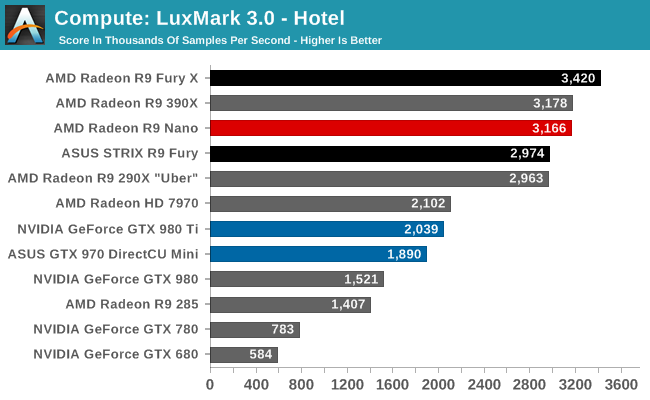
LuxMark ends up being a great corner case for where having a fully enabled Fiji GPU is more important than having the highest clockspeeds. With the R9 Nano able to flirt with its full 1000MHz clockspeed here, the card is able to pass the R9 Fury here. The only thing stopping it from taking the second-place spot is the R9 390X, as Hawaii still sees strong performance here even with fewer SPs.
For our second set of compute benchmarks we have CompuBench 1.5, the successor to CLBenchmark. CompuBench offers a wide array of different practical compute workloads, and we’ve decided to focus on face detection, optical flow modeling, and particle simulations.
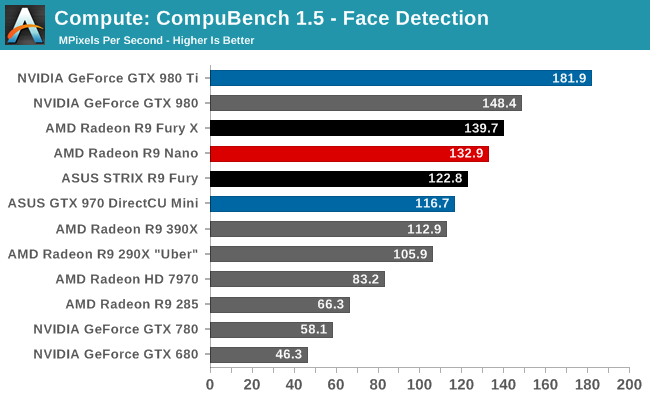
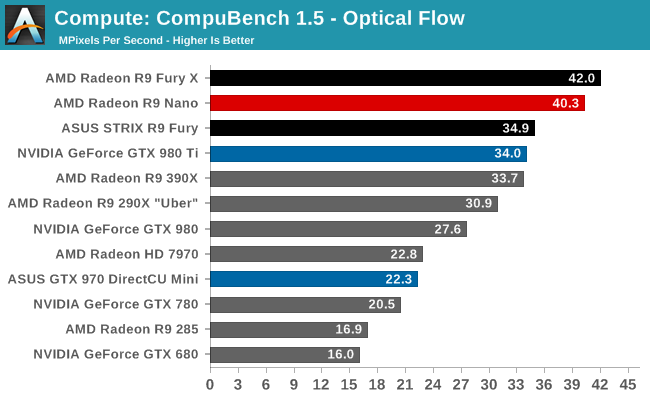
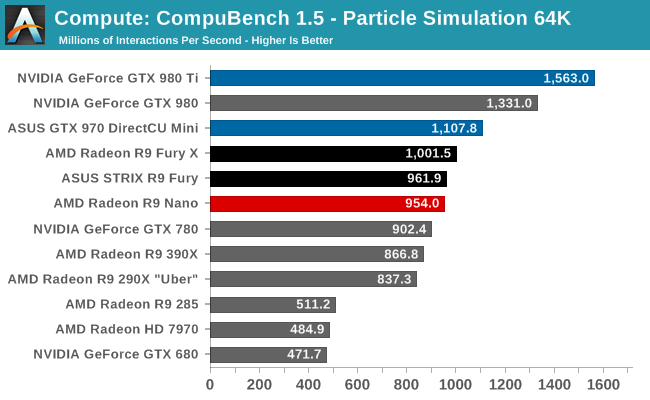
CompuBench provides us another case of where the R9 Nano ends up outpacing the R9 Fury. As a result AMD’s latest card tends to perform somewhere between an R9 Fury and R9 Fury X, with all of the strengths and weaknesses that come from that. This puts the R9 Nano in a good place for Optical Flow, while it will still trail NVIDIA”s best cards under Face Detection and the 64K particle simulation.
Meanwhile it’s interesting to note that AMD’s particle sim scores have significantly improved in the recent drivers. GCN 1.2 cards have seen 20%+ performance improvements here, which may point to some new OpenCL compiler optimizations from AMD.
Our 3rd compute benchmark is Sony Vegas Pro 13, an OpenGL and OpenCL video editing and authoring package. Vegas can use GPUs in a few different ways, the primary uses being to accelerate the video effects and compositing process itself, and in the video encoding step. With video encoding being increasingly offloaded to dedicated DSPs these days we’re focusing on the editing and compositing process, rendering to a low CPU overhead format (XDCAM EX). This specific test comes from Sony, and measures how long it takes to render a video.
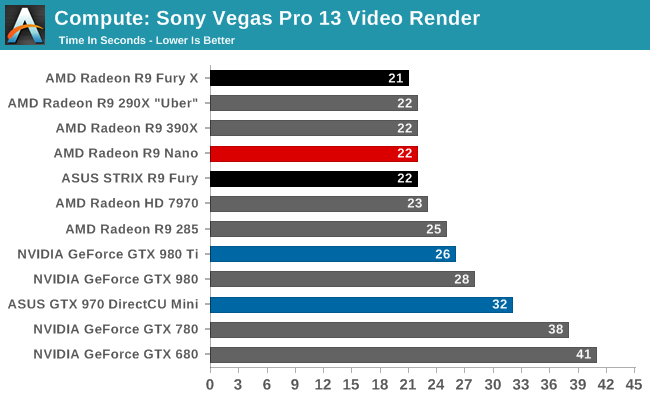
With Vegas there are no surprises; the R9 Nano ties the R9 Fury.
Moving on, our 4th compute benchmark is FAHBench, the official Folding @ Home benchmark. Folding @ Home is the popular Stanford-backed research and distributed computing initiative that has work distributed to millions of volunteer computers over the internet, each of which is responsible for a tiny slice of a protein folding simulation. FAHBench can test both single precision and double precision floating point performance, with single precision being the most useful metric for most consumer cards due to their low double precision performance. Each precision has two modes, explicit and implicit, the difference being whether water atoms are included in the simulation, which adds quite a bit of work and overhead. This is another OpenCL test, utilizing the OpenCL path for FAHCore 17.

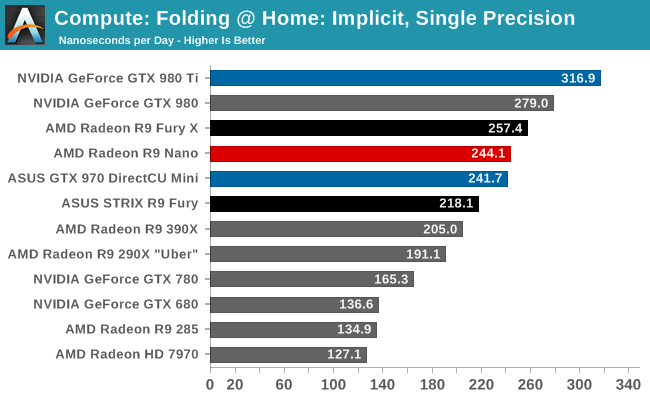
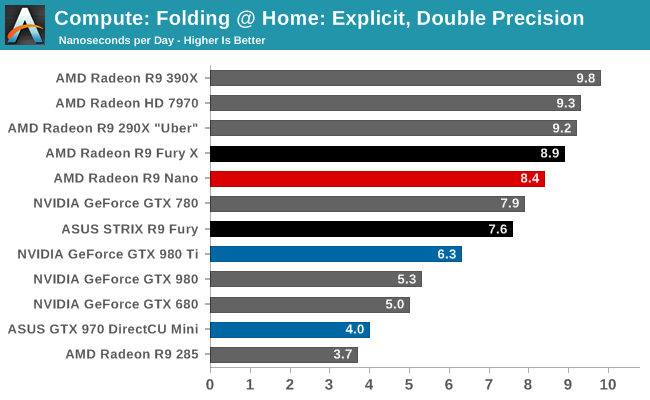
Much like CompuBench and LuxMark, the R9 Nano punches above its weight here. The lack of a graphics workload – and resulting demands on graphics hardware like the ROPs – means most of the card’s power can be allocated to the shaders, allowing higher clockspeeds. This gives the Nano a boost in this situation to bring it much closer to the Fury X, though as far as Folding goes AMD will still trail NVIDIA’s best cards.
Wrapping things up, our final compute benchmark is an in-house project developed by our very own Dr. Ian Cutress. SystemCompute is our first C++ AMP benchmark, utilizing Microsoft’s simple C++ extensions to allow the easy use of GPU computing in C++ programs. SystemCompute in turn is a collection of benchmarks for several different fundamental compute algorithms, with the final score represented in points. DirectCompute is the compute backend for C++ AMP on Windows, so this forms our other DirectCompute test.

Our final test sees the R9 Nano brought back to its place behind the R9 Fury, as the C++ AMP sub-tests are strenuous enough to cause more significant clockspeed throttling. Even behind the R9 Fury the R9 Nano does well for itself here, coming in behind the GTX 980 Ti and head of the R9 390X and GTX 980.










284 Comments
View All Comments
LoneWolf15 - Thursday, September 10, 2015 - link
And as someone who has been a long time TR reader and has met him multiple times, I am in complete disagreement with you. His testing is some of the most detailed and accurate that I know.I have little faith in your ability to determine someone's subliminal gifts.
Kutark - Thursday, September 10, 2015 - link
Unfortunately a great many people are incapable of projecting their own biases onto someone else. Tomshardware and Anandtech have been accused of being pro one team or the other for years.I remember an article i read a few years back, i wish i could remember the guys name, but he was chief editor for one of the macintosh magazines, and he was talking about how he got so fed up with users because if he said literally anything negative about the product he would get his email inbox blown up with accusations of being a MS nutswinger, and fellating Bill Gates, and various other things. He gave an example of one of the ipods which he gave like a 90%+ review, and the ONLY negative things he said was that the casing was shiny, so it took fingerprints really well and was hard to keep looking clean, and that he wished the battery life was a little bit longer. He said he got the most vitriolic and ridiculous emails he'd ever seen.
The problem is people want confirmation that they made the right choice, and if they don't get that, then rather than admit that they made a mistake, they would rather attack the reviewer as being a fanboy or something equally hideous.
medi03 - Friday, September 11, 2015 - link
In Fermi times Anand found it "appropriate" to compare cherry picked OCed nVidia card vs stock AMD."Subtle bias" my ass.
Ryan Smith - Friday, September 11, 2015 - link
It's something we've apologized for, repeatedly. It was a poor idea and we readily admit as much.http://www.anandtech.com/show/3988/the-use-of-evga...
mapesdhs - Monday, September 14, 2015 - link
I never saw the need to apologise; the price of the FTW meant it was the far better choice to buy back then (I bought two for SLI).fuicharles - Friday, September 11, 2015 - link
I used to go to The Tech Reports to read the Top News contents everyday. Their Top News was always updated and shared lots of recent development.However, recently something fishy, Tech Reports doesn't share any news on the recent Gamesworks and Asyn Compute tragedy in their sites.
And try to pin point the Pump Whine problem even after AMD has already come up new revision of Fury Card which solve the problems.
I don't want to believe Scott Wasson is biased either, but isn't that as a journalist you should share the bad/good for both camp to let the readers judge themselves
milli - Friday, September 11, 2015 - link
'most detailed and accurate' ≠ unbiasedDon't worry that you didn't notice the hidden bias. It took me a while to realize it. After reading TR for a couple years, around 2006 I started noticing the bias. It's not what he says that's biased but what he doesn't say/report that makes him biased. He's smart.
Well he's getting better at hiding his bias these last years. In the previous decade he would often pit OC'd nVidia cards with stock AMD cards in his 'reviews'.
Just like many knew that Anand was biased towards Apple with his ridiculously positive reviews until the final proof came when he went to actually work for them.
slickr - Saturday, September 12, 2015 - link
He has been shilling for Nvidia for good several years now, everything Nvidia does = great, amazing, unique, always winning in some ultra specific aspect even if realistically the card is garbage, when he talks about AMD = power consumption is 10W or 20W more than Nvidia, Nvidia clear winner, price and performance don't matter, only those 10W difference matters.No way for AMD to win, I would have not sent review copies to a whole more websites, there are at least 4-5 of top of my head that are Nvidia shill town and they not even doing it subtly.
althaz - Monday, September 14, 2015 - link
nVidia have had a lead in performance for half a decade or more now - it's not tech reviewers fault that AMD are using more power to deliver worse performance at similar prices.chrnochime - Saturday, September 12, 2015 - link
And we're suppose to have faith in YOUR view of SW? LOL